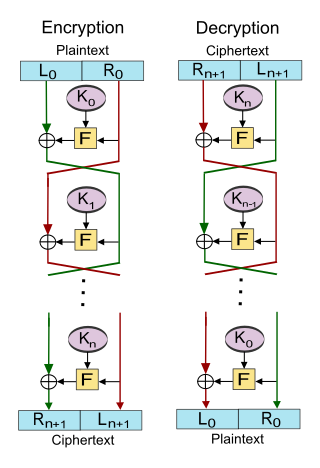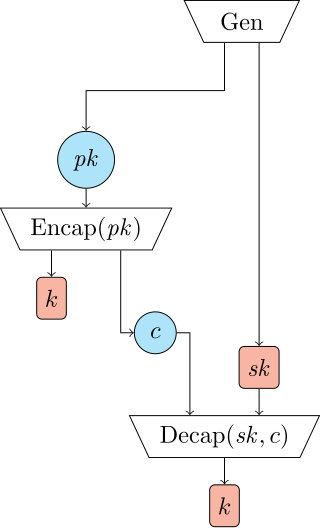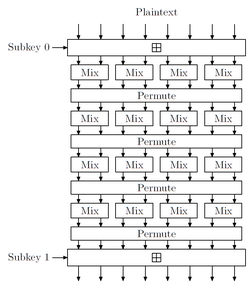In cryptography, a block cipher is a deterministic algorithm that operates on fixed-length groups of bits, called blocks. Block ciphers are the elementary building blocks of many cryptographic protocols. They are ubiquitous in the storage and exchange of data, where such data is secured and authenticated via encryption.
The Digital Signature Algorithm (DSA) is a public-key cryptosystem and Federal Information Processing Standard for digital signatures, based on the mathematical concept of modular exponentiation and the discrete logarithm problem. In a public-key cryptosystem, two keys are generated: data can only be encrypted with the public key and encrypted data can only be decrypted with the private key. DSA is a variant of the Schnorr and ElGamal signature schemes.

In cryptography, a Feistel cipher is a symmetric structure used in the construction of block ciphers, named after the German-born physicist and cryptographer Horst Feistel, who did pioneering research while working for IBM; it is also commonly known as a Feistel network. A large number of block ciphers use the scheme, including the US Data Encryption Standard, the Soviet/Russian GOST and the more recent Blowfish and Twofish ciphers. In a Feistel cipher, encryption and decryption are very similar operations, and both consist of iteratively running a function called a "round function" a fixed number of times.
In cryptography, the Elliptic Curve Digital Signature Algorithm (ECDSA) offers a variant of the Digital Signature Algorithm (DSA) which uses elliptic-curve cryptography.
KCDSA is a digital signature algorithm created by a team led by the Korea Internet & Security Agency (KISA). It is an ElGamal variant, similar to the Digital Signature Algorithm and GOST R 34.10-94. The standard algorithm is implemented over , but an elliptic curve variant (EC-KCDSA) is also specified.
In cryptography, a universal hashing message authentication code, or UMAC, is a message authentication code (MAC) calculated using universal hashing, which involves choosing a hash function from a class of hash functions according to some secret (random) process and applying it to the message. The resulting digest or fingerprint is then encrypted to hide the identity of the hash function that was used. A variation of the scheme was first published in 1999. As with any MAC, it may be used to simultaneously verify both the data integrity and the authenticity of a message. In contrast to traditional MACs, which are serializable, a UMAC can be executed in parallel. Thus, as machines continue to offer more parallel-processing capabilities, the speed of implementing UMAC can increase.
Poly1305 is a universal hash family designed by Daniel J. Bernstein in 2002 for use in cryptography.
The ElGamal signature scheme is a digital signature scheme which is based on the difficulty of computing discrete logarithms. It was described by Taher Elgamal in 1985.
The GOST hash function, defined in the standards GOST R 34.11-94 and GOST 34.311-95 is a 256-bit cryptographic hash function. It was initially defined in the Russian national standard GOST R 34.11-94 Information Technology – Cryptographic Information Security – Hash Function. The equivalent standard used by other member-states of the CIS is GOST 34.311-95.
The Blum–Goldwasser (BG) cryptosystem is an asymmetric key encryption algorithm proposed by Manuel Blum and Shafi Goldwasser in 1984. Blum–Goldwasser is a probabilistic, semantically secure cryptosystem with a constant-size ciphertext expansion. The encryption algorithm implements an XOR-based stream cipher using the Blum-Blum-Shub (BBS) pseudo-random number generator to generate the keystream. Decryption is accomplished by manipulating the final state of the BBS generator using the private key, in order to find the initial seed and reconstruct the keystream.
Disk encryption is a special case of data at rest protection when the storage medium is a sector-addressable device. This article presents cryptographic aspects of the problem. For an overview, see disk encryption. For discussion of different software packages and hardware devices devoted to this problem, see disk encryption software and disk encryption hardware.

In cryptography, a one-way compression function is a function that transforms two fixed-length inputs into a fixed-length output. The transformation is "one-way", meaning that it is difficult given a particular output to compute inputs which compress to that output. One-way compression functions are not related to conventional data compression algorithms, which instead can be inverted exactly or approximately to the original data.
In mathematics and computing, universal hashing refers to selecting a hash function at random from a family of hash functions with a certain mathematical property. This guarantees a low number of collisions in expectation, even if the data is chosen by an adversary. Many universal families are known, and their evaluation is often very efficient. Universal hashing has numerous uses in computer science, for example in implementations of hash tables, randomized algorithms, and cryptography.
For a cryptographic hash function, a MASH-1 is a hash function based on modular arithmetic.

In cryptography, a key encapsulation mechanism, or KEM, is a public-key cryptosystem that allows a sender to generate a short secret key and transmit it to a receiver securely, in spite of eavesdropping and intercepting adversaries. Modern standards for public-key encryption of arbitrary messages are usually based on KEMs.
In cryptography, M8 is a block cipher designed by Hitachi in 1999. It is a modification of Hitachi's earlier M6 algorithm, designed for greater security and high performance in both hardware and 32-bit software implementations. M8 was registered by Hitachi in March 1999 as ISO/IEC 9979-0020.

Skein is a cryptographic hash function and one of five finalists in the NIST hash function competition. Entered as a candidate to become the SHA-3 standard, the successor of SHA-1 and SHA-2, it ultimately lost to NIST hash candidate Keccak.
SHA-3 is the latest member of the Secure Hash Algorithm family of standards, released by NIST on August 5, 2015. Although part of the same series of standards, SHA-3 is internally different from the MD5-like structure of SHA-1 and SHA-2.
A biclique attack is a variant of the meet-in-the-middle (MITM) method of cryptanalysis. It utilizes a biclique structure to extend the number of possibly attacked rounds by the MITM attack. Since biclique cryptanalysis is based on MITM attacks, it is applicable to both block ciphers and (iterated) hash-functions. Biclique attacks are known for having weakened both full AES and full IDEA, though only with slight advantage over brute force. It has also been applied to the KASUMI cipher and preimage resistance of the Skein-512 and SHA-2 hash functions.
In cryptography, a known-key distinguishing attack is an attack model against symmetric ciphers, whereby an attacker who knows the key can find a structural property in cipher, where the transformation from plaintext to ciphertext is not random. There is no common formal definition for what such a transformation may be. The chosen-key distinguishing attack is strongly related, where the attacker can choose a key to introduce such transformations.









































